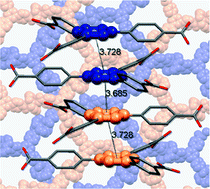Four new coordination polymer frameworks, namely [(NiL1)3(BTB)2]·6H2O, [(NiL2)3(BTB)2]·6H2O, [(NiL3)3(BTB)2]·6H2O and [(NiL2)3(BTC)2]·10.25H2O (L1 = 1,4,8,11-tetraazacyclotetradecane, L2 = 3-methyl-1,3,5,8,12-pentaazacyclotetradecane, L3 = 3,10-dimethyl-1,3,5,8,10,12-hexaazacyclotetradecane, BTC3− = benzene-1,3,5-tricarboxylate, BTB3− = 4,4′,4′′-benzene-1,3,5-triyl-tribenzoate) were prepared in water–N,N-dimethylformamide solutions. The molecular and crystal structures of these compounds are compared to the related coordination polymers formed by nickel(II) macrocyclic cations to examine the effect of carboxylate linker size on the framework architecture. Luminescent properties of the complexes based on the BTB3− bridging ligand are also discussed.


 Please wait while we load your content...
Please wait while we load your content...